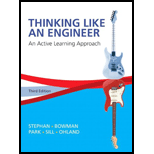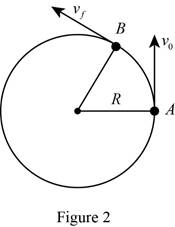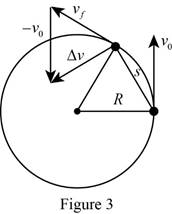
Concept explainers
- 10. Show that for circular motion, force = mass * velocity squared/radius.
Show that the force of the circular motion is,
Answer to Problem 10MDP
The force of the circular motion is proved as
Explanation of Solution
Circular motion is defined as the movement of an object along a circular path. When an object is moved at constant speed, the velocity is changed due to its direction not because of its magnitude. This changing velocity shows that the object is accelerating. To obtain this accelerating there should be a force which is called as centripetal force.
The derivation of the force of the circular motion is as follows,
Consider a ball moving with the constant speed

To derive the acceleration consider the initial velocity at
Now modify Figure 1 as shown in Figure 2.

Use the similar triangles in Figure2, therefore it becomes as follows:

The acceleration is the rate of change of velocity.
Using similar triangle theorem,
The arc with the chord is,
Rearrange equation (3) to find
Rearrange equation (2) to find
Substitute equation (5) in equation (1) to obtain the expression of acceleration in terms of
Substitute
Write the expression for force.
Substitute equation (7) in (8) to obtain the expression force of the circular motion.
Here,
Therefore, the equation (9) shows the force of the circular motion.
Conclusion:
Thus, the force of the circular motion is proved as
Want to see more full solutions like this?
Chapter 3 Solutions
Thinking Like an Engineer: An Active Learning Approach (3rd Edition)
Additional Engineering Textbook Solutions
Applied Fluid Mechanics (7th Edition)
Engineering Mechanics: Dynamics (14th Edition)
INTERNATIONAL EDITION---Engineering Mechanics: Statics, 14th edition (SI unit)
Statics and Mechanics of Materials (5th Edition)
Automotive Technology: Principles, Diagnosis, and Service (5th Edition)
Applied Statics and Strength of Materials (6th Edition)
- J 5: !!!Please show it mathematically, not theoryarrow_forward1) Derive an expression for power extracted from wind turbines' blades as function of rotor efficiency. 2) Determine when the rotor efficiency is maximum and find the maximum efficiency of wind turbine. 3) Plot the rotor efficiency vs wind speed ratio.arrow_forward3.16 Do you think that the Aberdeen Three knew about RCRA? If not, should theyhave? Does it really matter if they knew about RCRA or not?arrow_forward
 Principles of Heat Transfer (Activate Learning wi...Mechanical EngineeringISBN:9781305387102Author:Kreith, Frank; Manglik, Raj M.Publisher:Cengage Learning
Principles of Heat Transfer (Activate Learning wi...Mechanical EngineeringISBN:9781305387102Author:Kreith, Frank; Manglik, Raj M.Publisher:Cengage Learning
